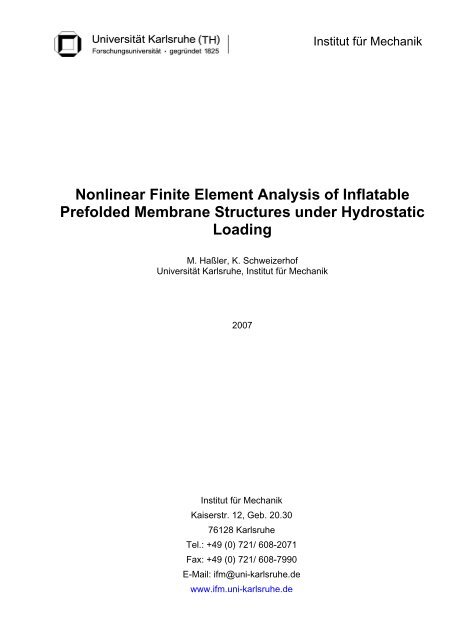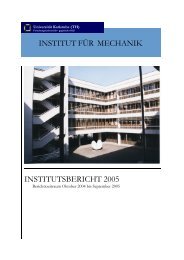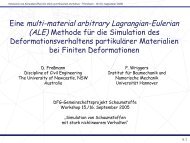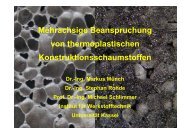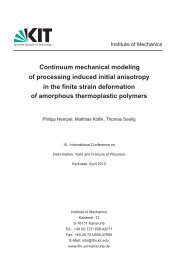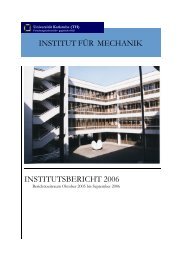Nonlinear Finite Element Analysis of Inflatable Prefolded Membrane ...
Nonlinear Finite Element Analysis of Inflatable Prefolded Membrane ...
Nonlinear Finite Element Analysis of Inflatable Prefolded Membrane ...
Create successful ePaper yourself
Turn your PDF publications into a flip-book with our unique Google optimized e-Paper software.
Institut für Mechanik<br />
<strong>Nonlinear</strong> <strong>Finite</strong> <strong>Element</strong> <strong>Analysis</strong> <strong>of</strong> <strong>Inflatable</strong><br />
<strong>Prefolded</strong> <strong>Membrane</strong> Structures under Hydrostatic<br />
Loading<br />
M. Haßler, K. Schweizerh<strong>of</strong><br />
Universität Karlsruhe, Institut für Mechanik<br />
2007<br />
Institut für Mechanik<br />
Kaiserstr. 12, Geb. 20.30<br />
76128 Karlsruhe<br />
Tel.: +49 (0) 721/ 608-2071<br />
Fax: +49 (0) 721/ 608-7990<br />
E-Mail: ifm@uni-karlsruhe.de<br />
www.ifm.uni-karlsruhe.de
<strong>Nonlinear</strong> <strong>Finite</strong> <strong>Element</strong> <strong>Analysis</strong> <strong>of</strong> <strong>Inflatable</strong> <strong>Prefolded</strong><br />
<strong>Membrane</strong> Structures under Hydrostatic Loading<br />
M. Haßler and K. Schweizerh<strong>of</strong><br />
20. August 2007<br />
Due to their flexibility shell or membrane like structures subjected to gas or fluid<br />
loading or gas/fluid support undergo large deformations. In order to describe this<br />
deformation dependent loading, where value and direction <strong>of</strong> the pressure loading<br />
are a function <strong>of</strong> the current configuration <strong>of</strong> the shell structure, the gas or fluid<br />
volumes, which are enclosed by the thin walled structure, have to be considered<br />
for the appropriate constitutive equations. Then the numerical formulation <strong>of</strong> the<br />
fluid or gas loading can be derived via an analytical meshfree description for the<br />
fluid/gas, which yields a special structure <strong>of</strong> equations involving the change <strong>of</strong> the<br />
gas or fluid volume respectively the change <strong>of</strong> the wetted part <strong>of</strong> the shell surface, see<br />
[2],[11],[12],[13]. This procedure finally leads to the so-called load-stiffness matrix,<br />
to which (in the case <strong>of</strong> enclosed gas/fluid volumes) several rank updates describing<br />
the coupling <strong>of</strong> the fluid or gas with the structural displacements in addition to the<br />
deformation dependence <strong>of</strong> the pressure load [15] are added. The numerical examples<br />
<strong>of</strong> e.g. a) deploying simply folded membrane structures and b) multi-chamber<br />
structures containing fluid and air in arbitrary combination demonstrate, how the<br />
simulation <strong>of</strong> structures with static gas and fluid loading or support can be efficiently<br />
performed without discretizing the fluid resp. the gas.<br />
Key words: fluid-structure interaction; hydrostatic loading; gas loading; large displacements;<br />
volume dependence; finite elements<br />
1 Introduction<br />
<strong>Inflatable</strong> structures nowadays find a wide field <strong>of</strong> applications, such as gas supported<br />
beams [6] in the field <strong>of</strong> civil engineering or deployable space structures [4] in<br />
aerospace engineering. Even in the field <strong>of</strong> hydraulic engineering inflatable membranes<br />
are used for gas and/or heavy fluid supported dams [5], which allow a direct<br />
control <strong>of</strong> the water retention level just by controlling the internal gas pressure. In<br />
conventional simulations these inner state variables (e.g. the internal gas pressure)<br />
<strong>of</strong> gas/fluid supported structures are transferred into pure loading quantities, which<br />
are not affected by the deformation. The fact that the applied gas or fluid pressure<br />
is volume dependent is <strong>of</strong>ten neglected as also for example the volume dependence<br />
<strong>of</strong> the current fluid level.<br />
The aim <strong>of</strong> this contribution is a large deformation analysis, which includes both<br />
the volume and the shape dependence <strong>of</strong> the inner state variables. For this purpose<br />
we refer to former contributions <strong>of</strong> the authors group [11], [12], [13] and the<br />
1
works <strong>of</strong> Bonet et al. [2], which dealt with gas and fluid supported shell structures<br />
and considered both the shape and volume dependence <strong>of</strong> the hydrostatic pressure<br />
distribution. With these derivations it is possible to come up with an analytical formulation<br />
<strong>of</strong> the fluid/gas only described by surface integrals over the surrounding<br />
wetted structure. Hence no discretization <strong>of</strong> the fluid or the gas e.g. by FE or boundary<br />
elements is necessary. A further contribution <strong>of</strong> the authors group currently<br />
being in progress [7] merges all these results and thus provides a unified formulation<br />
for closed chambers containing any combination <strong>of</strong> volume dependent loading. Therefore<br />
the notations in the current contribution were adopted from [7].<br />
First the necessary governing equations <strong>of</strong> the problem will be briefly derived via<br />
their virtual work expressions. In a further step the obtained variation <strong>of</strong> the gas/fluid<br />
potential has to be linearized for a Newton-type solution algorithm. After FEdicretization<br />
<strong>of</strong> the linearized weak form the so-called load stiffness matrix (see<br />
also [14], [15]) is obtained, which is updated by several dyadic products, reflecting<br />
the volume dependence <strong>of</strong> the inner state variables. The numerical examples contain<br />
large deformation analyses <strong>of</strong> fluid and gas filled multi chamber systems with rather<br />
thin flexible walls and illustrate the performance <strong>of</strong> the derived algorithm.<br />
2 Governing Equations<br />
The general problem <strong>of</strong> thin walled shells containing gas and/or fluid (see figure 2.1)<br />
is prescribed by its properties <strong>of</strong> the potential energy Π, which consists <strong>of</strong> the - here<br />
for simplicity - elastic potential Π el <strong>of</strong> the surrounding structure <strong>of</strong> the containment,<br />
the potential Π fsi <strong>of</strong> the internal fluid and gas and the work W ex <strong>of</strong> the external<br />
forces. For equilibrium the variation <strong>of</strong> the total potential energy then vanishes<br />
identically.<br />
g<br />
n g<br />
f ex p kg<br />
¯v g<br />
n o<br />
n f<br />
ρ, ¯v f<br />
2<br />
0000000<br />
1111111<br />
0000000<br />
1111111<br />
0000000<br />
1111111<br />
0000000<br />
1111111<br />
0000000<br />
1111111<br />
1<br />
Bild 2.1: Elastic shell structure filled with fluid and gas<br />
2.1 Virtual Work Expression<br />
The variation δΠ <strong>of</strong> the total potential energy is given by the variation <strong>of</strong> its parts:<br />
δΠ = δΠ el + δΠ fsi − δW ex = 0 (2.1)<br />
For the elastic energy and the work <strong>of</strong> the standard external loading, such as e.g.<br />
dead loading, we refer to standard FE-text books [17], [19]. In the following the focus<br />
2
is only on the potential <strong>of</strong> the fluid-structure-interaction (fsi) part and the gas or<br />
fluid loading,<br />
δΠ fsi = δV f − δW g − δW f , (2.2)<br />
which consists <strong>of</strong> the virtual gravity potential δV f <strong>of</strong> the heavy fluid, the virtual<br />
work δW g <strong>of</strong> the gas compression and the virtual work δW f <strong>of</strong> the fluid compression,<br />
which is actually zero for an incompressible fluid. Because all terms have already<br />
been derived in detail in [7] and [10], they will only be briefly presented in this<br />
contribution. The virtual potential<br />
δV f = −δρg · ¯s f − ρg · δ¯s f (2.3)<br />
due to acceleration <strong>of</strong> gravity g can be written in terms <strong>of</strong> the fluid density ρ and<br />
its first order volume moment<br />
∫<br />
¯s = x f dv . (2.4)<br />
¯v f<br />
The virtual work <strong>of</strong> the gas volume compression (see also [18])<br />
δW g = p kg δ¯v g (2.5)<br />
consists <strong>of</strong> the gas volume change δ¯v g and <strong>of</strong> the volume dependent gas pressure<br />
p kg (¯v g ) κ = const (with the isentropic exponent κ) . (2.6)<br />
2.2 Boundary Integral Representation <strong>of</strong> the Geometry<br />
In section 2.1 the variation <strong>of</strong> the fluid potential was given in terms <strong>of</strong> the variables<br />
δ¯v g and δ¯s f describing the geometrical attributes <strong>of</strong> the fluid and gas. Consequently<br />
the second step will now be the representation <strong>of</strong> these geometrical variables by<br />
boundary integrals, enabling an analytical meshfree description <strong>of</strong> the enclosed gas<br />
and heavy fluid via their surrounding wetted surface. Sectioning both control volumes<br />
¯v g and ¯v f in figure 2.1 yields along with a three dimensional projection <strong>of</strong> the<br />
geometry the necessary virtual geometrical variables. Thus we obtain the virtual gas<br />
volume and the virtual first order volume moment <strong>of</strong> the heavy fluid as:<br />
δ¯v g =<br />
δ¯s f =<br />
∫η g ∫<br />
ξ g n g · δu g dξdη −<br />
∫η o ∫<br />
ξ o n o · δu o dξdη , (2.7)<br />
(<br />
n<br />
∫η<br />
∫ξ f · δu f) ∫<br />
x f dξdη + (n<br />
∫η o · δu o ) x o dξdη . (2.8)<br />
f f o ξ o<br />
In equations (2.7) and (2.8) n g denotes the non-normalized normal vector on the gas<br />
boundary and n f and n o the non-normalized normal vectors on the fluid boundary<br />
and on the fluid level. x f and x o define the position vectors to a wetted structural<br />
point and to the fluid surface. δu g , δu f and δu o denote the virtual displacement on<br />
the particular boundary.<br />
3
g<br />
x o n g<br />
p kg<br />
p kg p o p x<br />
x<br />
00 11<br />
00 11<br />
n f<br />
p f<br />
= + +<br />
Bild 2.2: Hydrostatic pressure distribution in a chamber filled with gas and an incompressible<br />
heavy fluid<br />
2.2.1 Incompressible fluid with free fluid surface and additional gas loading<br />
The gas and fluid pressure distribution for this case is depicted in figure 2.2. Using<br />
equations (2.7) and (2.8) in (2.2) gives us along with the pressure values<br />
p x = ρg · x (2.9)<br />
p o = ρg · x o (2.10)<br />
p f = p o − p x − p kg (2.11)<br />
the virtual gas and fluid potential for an incompressible fluid with free fluid surface<br />
and additional gas loading<br />
δΠ fsi =<br />
∫η f ∫<br />
3 Linearization<br />
ξ f p f n f · δu f dξdη −<br />
∫η g ∫<br />
ξ g p kg n g · δu g dξdη . (2.12)<br />
The virtual expression (2.12) is now written as a Taylor series expansion up to the<br />
first order term in order to embed it into a numerical solution procedure, e.g. in<br />
a Newton-type scheme. A consequent linearization <strong>of</strong> the virtual work (2.12) at a<br />
given state t then leads to<br />
δΠ fsi<br />
lin<br />
=<br />
+<br />
+<br />
• Residual<br />
∫η f ∫<br />
ξ f p f t nf t · δuf dξdη +<br />
• Pressure change parts<br />
∫η f ∫<br />
ξ f ∆p f n f t · δuf dξdη +<br />
• Normal change parts<br />
∫η f ∫<br />
ξ f p f t ∆n f · δu f dξdη +<br />
∫η g ∫<br />
∫η g ∫<br />
∫η g ∫<br />
ξ g p kg<br />
t n g t · δug dξdη<br />
ξ g ∆p kg n g t · δug dξdη<br />
ξ g p kg<br />
t ∆n g · δu g dξdη (3.1)<br />
4
3.1 Incremental pressure changes<br />
The incremental pressure changes can also be directly adopted from [13], [7]. The<br />
mass conservation <strong>of</strong> the fluid and the adiabatic state equation <strong>of</strong> an ideal gas with<br />
the isentropic exponent κ then lead to the change <strong>of</strong> the gas pressure<br />
∫ ∫<br />
∫ ∫<br />
∆p kg = −α t n g<br />
η g ξ g t · ∆ug dξdη − α t n f<br />
η f ξ f t · ∆uf dξdη , (3.2)<br />
with<br />
α t = κ pkg<br />
¯v g , (3.3)<br />
the change <strong>of</strong> the pressure at the fluid surface<br />
∆p o = −γ t<br />
∫<br />
with<br />
γ t = −ρ t<br />
(∫<br />
η f ∫<br />
η f ∫<br />
ξ f n f t · ∆uf dξdη , (3.4)<br />
ξ f n f t · gdξdη ) −1<br />
(3.5)<br />
and the change <strong>of</strong> the position dependend pressure<br />
∆p x = ρ t g · ∆u f . (3.6)<br />
3.2 Normal change parts<br />
The parts for the gas and fluid domains involving the change <strong>of</strong> the normals <strong>of</strong> the<br />
wetted surface parts can be adopted from [11] and [12]. For the fluid domain the<br />
specific part due to the non-constant pressure distribution p x t must be considered<br />
[15]. By introducing the skewsymmetric tensors (see also [14] and [9])<br />
W ¯ξ<br />
= n t ⊗ x ,¯ξ − x ,¯ξ ⊗ n t (3.7)<br />
W ¯η = n t ⊗ x ,¯η − x ,¯η ⊗ n t (3.8)<br />
in a convective basis x ,¯ξ ⊗x ,¯η , with ¯ξ, ¯η as the contravariant curvilinear coordinates,<br />
we obtain the normal change parts <strong>of</strong> the linearized virtual work as follows:<br />
⎛<br />
p<br />
δΠ ∆ng<br />
lin =<br />
∫η<br />
∫ξ kg δu g ⎞ ⎛<br />
0 W ¯ξ W ¯η ⎞ ⎛<br />
∆u g ⎞<br />
t ⎜<br />
⎝ δu g ⎟ ⎜<br />
,ξ ⎠ · ⎝ W ¯ξT ⎟ ⎜<br />
0 0 ⎠ ⎝ ∆u g ⎟<br />
,ξ ⎠ dξdη (3.9)<br />
g g 2<br />
W ¯ηT 0 0<br />
δu g ,η<br />
∆u g ,η<br />
δΠ ∆nf<br />
lin =<br />
∫η f ∫<br />
−<br />
ξ f p f t<br />
2<br />
⎛<br />
⎜<br />
⎝<br />
δu f<br />
δu f ,ξ<br />
δu f ,η<br />
⎞<br />
⎛<br />
⎟ ⎜<br />
⎠ · ⎝<br />
0 W ¯ξ W ¯η<br />
W ¯ξT 0 0<br />
W ¯ηT 0 0<br />
∫η f ∫ξ f [<br />
p f t,ξ (x ,η × δu f ,ξ ) − pf t,η (x ,ξ × δu f ,η)<br />
⎞ ⎛<br />
∆u f<br />
∆u f ,ξ<br />
⎟ ⎜<br />
⎠ ⎝<br />
∆u f ,η<br />
]<br />
⎞<br />
⎟<br />
⎠ dξdη<br />
· ∆u f dξdη (3.10)<br />
5
3.3 Pro<strong>of</strong> <strong>of</strong> Conservativeness<br />
As shown in [14] and [9] by partial integration and subsequent application <strong>of</strong> the<br />
Gauss theorem the formally unsymmetric part in equation (3.10) can be transformed<br />
into a skew symmetric field term and an unsymmetric boundary term. Assuming<br />
physically realistic boundary conditions makes this boundary term to vanish. A<br />
complete symmetry <strong>of</strong> the linearized virtual work δΠ fsi<br />
lin<br />
is finally obtained, if the<br />
linearized pressure parts (3.2), (3.4) and (3.6) along with the normal change parts<br />
(3.9) and (3.10) are inserted in the initial equation (3.1). Further on, if ρ t g · ∆u<br />
from equation (3.6) is split up into a symmetric and a skewsymmetric part, this<br />
skewsymmetric part neutralizes with the remainig skewsymmetric term in (3.10).<br />
Thus only the symmetric part from the position dependent pressure over the fluid<br />
boundary remains. The result clearly proves formally the conservativeness <strong>of</strong> the<br />
complete problem, which by general physical consideration is conservative from the<br />
origin.<br />
The symmetry <strong>of</strong> the derived equations will appear clearer after the following FEdiscretization.<br />
3.4 <strong>Finite</strong> <strong>Element</strong> Mapping<br />
After discretizing the linearized virtual fluid structure interaction expression with<br />
isoparametric mapping functions N for the displacements, the virtual displacements<br />
and the incremental displacements <strong>of</strong> the structural parts which are in contact with<br />
gas/fluid, such that<br />
u = Nd , δu = Nδd and ∆u = N∆d , (3.11)<br />
we obtain from the normal change parts the symmetric load stiffness matrices for<br />
each structural element in contact with gas and/or fluid (see also [15], [9], [10], [11],<br />
[12]):<br />
⎛ ⎞T ⎛<br />
K g elem = 1 ∫ N 0 W<br />
p<br />
2<br />
∫η ¯ξ W ¯η ⎞ ⎛<br />
g ⎜<br />
g ξ g t ⎝ N ⎟ ⎜ ,ξ ξT<br />
⎠ ⎝ W ¯ ⎟ ⎜<br />
0 0 ⎠ ⎝<br />
N ηT ,η W ¯ 0 0<br />
K f elem = 1 2<br />
− ρ t<br />
2<br />
∫η f ∫<br />
ξ f p f t<br />
∫η f ∫<br />
⎛ ⎞<br />
N<br />
⎜<br />
⎝ N ⎟ ,ξ ⎠<br />
N ,η<br />
T ⎛<br />
0 W ¯ξ W ¯η ⎞ ⎛<br />
⎜ ξT<br />
⎝ W ¯ ⎟ ⎜<br />
0 0 ⎠ ⎝<br />
ηT<br />
W ¯ 0 0<br />
ξ f N T ( n f t ⊗ g + g ⊗ nf t<br />
⎞<br />
N<br />
N ⎟ ,ξ<br />
N ,η<br />
⎠ dξdη ,(3.12)<br />
⎞<br />
N<br />
N ⎟ ,ξ ⎠ dξdη<br />
N ,η<br />
)<br />
N dξdη . (3.13)<br />
The residual for the corresponding element results in negative right hand side vectors<br />
due to fluid and gas pressure loading/support following the definitions <strong>of</strong> the normals<br />
given in figure 2.1:<br />
∫ ∫<br />
f g elem = − p kg<br />
η g ξ g t N T n g t dξdη , (3.14)<br />
f f elem = ∫<br />
∫ (<br />
−p kg<br />
η f ξ f t<br />
+ p o t − p x t<br />
)<br />
N T n f t<br />
dξdη . (3.15)<br />
6
Hence along with the coupling vectors reflecting the closed volumes<br />
a elem =<br />
b elem =<br />
∫η g ∫<br />
∫η f ∫<br />
ξ g N T n g t<br />
dξdη and (3.16)<br />
ξ f N T n f t dξdη (3.17)<br />
for the elements in contact with gas/fluid and after assembling all local arrays in<br />
their corresponding global arrays the linearized state <strong>of</strong> equilibrium for a closed<br />
single chamber system partially filled with an incompressible fluid and gas can be<br />
written as:<br />
(<br />
K el + K g + K f + α t (a + b)(a + b) T − γ t bb T ) ∆d =<br />
f ex − f el − f f − f g (3.18)<br />
In equation (3.18) the volume dependence <strong>of</strong> the enclosed gas and fluid is reflected<br />
in the rank updates <strong>of</strong> the stiffness matrix with two dyadic products <strong>of</strong> the coupling<br />
vectors for each closed volume.<br />
3.5 Multichamber Problems<br />
g<br />
p kg<br />
3<br />
x o 3 ρ 3<br />
p kg<br />
1<br />
p kg<br />
2<br />
ρ 2<br />
x o 2<br />
x o 1<br />
2<br />
1<br />
ρ 1<br />
0000000<br />
1111111<br />
0000000<br />
1111111<br />
0000000<br />
1111111<br />
0000000<br />
1111111<br />
0000000<br />
1111111<br />
Bild 3.1: Multichamber problem with n = 3 interacting fluid and gas filled chambers<br />
The derived procedure can easily be expanded to problems, where multiple fluid<br />
and/or gas filled chambers are connected to each other. For such systems the corresponding<br />
global arrays (load-stiffness matrices, coupling vectors and right hand<br />
side vectors) have to be set up for each chamber and must be summed up for all n<br />
chambers.<br />
(<br />
K el +<br />
n∑<br />
i=1<br />
[<br />
] )<br />
K g i + Kf i + α i,t (a i + b i )(a i + b i ) T − γ i,t b i b T i ∆d<br />
= f ex − f el −<br />
n∑<br />
i=1<br />
[ ]<br />
f f i + fg i<br />
(3.19)<br />
7
These multiple rank updates due to the volume dependence <strong>of</strong> the inner state variables<br />
<strong>of</strong> the fluid and gas lead to a fully populated system matrix. However, in order<br />
to save memory and computational effort during the solution process it is desirable<br />
to have matrices with band structure. Therefore in the next section a solution algorithm<br />
is presented, which benefits from the dyadic rank updates preserving the<br />
band structure.<br />
4 Solution<br />
In figure 4.1 a solution algorithm to solve equation systems like (3.19) with n dyadic<br />
updates is briefly presented. A more detailled derivation <strong>of</strong> this procedure, which<br />
bases on a sequential application <strong>of</strong> the Sherman-Morrison formula, can be found in<br />
[7]. Most important in this recursive scheme, starting from the conventional solution<br />
∆d 0 , is that only a few vectors and scalars need to be stored within a single solution<br />
step, which keeps the memory requirements low.<br />
∆d 0 = K −1 f<br />
i = 1..n,1<br />
j = 0..i − 1,1<br />
j = 0 <br />
yes<br />
r ji = −K −1 a i<br />
no<br />
r ji = β j r j−1,j b T j r j−1,i + r j−1,i<br />
α = b T i d i−1<br />
β i =<br />
( ) −1<br />
1 − b T i r i−1,i<br />
∆d i = α β i r i−1,i + ∆d i−1<br />
∆d = ∆d n<br />
Bild 4.1: Recursive scheme for the computation <strong>of</strong> the auxiliary vectors r ji , the parameters<br />
β i and the interim solutions ∆d i in the vectorized Sherman-Morrison algorithm<br />
5 Numerical Examples<br />
The inflation and hydrostatic loading <strong>of</strong> a rubber dam under serveral boundary<br />
conditions will serve as an example with varying support and loading conditions.<br />
Figure 5.1 illustrates such an inflatable dam under hydrostatic loading: hydrodynamic<br />
effects will not be considered in these examples. The rubber dam consists<br />
<strong>of</strong> two membrane parts, which are hot volcanized along one edge resulting in the<br />
typical deflection fin, which is used to reduce vibrations. Along the other edge the<br />
two membrane layers are clamped and anchored to the ground. The most important<br />
task <strong>of</strong> weirs is the adjustment <strong>of</strong> the water retention level resp. the dam height,<br />
8
which allows to take control <strong>of</strong> the discharge. In the case <strong>of</strong> inflatable dams the<br />
dam height h can be regulated by the internal gas pressure. Analytical solutions for<br />
different load cases can be found in [1] assuming purely membrane conditions and<br />
bending free joining <strong>of</strong> the membrane parts. The following computations to simula-<br />
x o head<br />
h<br />
00000000000000000000000000000<br />
11111111111111111111111111111<br />
00000000000000000000000000000<br />
11111111111111111111111111111<br />
00000000000000000000000000000<br />
11111111111111111111111111111<br />
00000000000000000000000000000<br />
11111111111111111111111111111<br />
00000000000000000000000000000<br />
11111111111111111111111111111<br />
00000000000000000000000000000<br />
11111111111111111111111111111<br />
x o 00000000000000000000000000000<br />
11111111111111111111111111111<br />
bottom<br />
00000000000000000000000000000<br />
11111111111111111111111111111<br />
00000000000000000000000000000<br />
11111111111111111111111111111<br />
00000000000000000000000000000<br />
11111111111111111111111111111<br />
00000000000000000000000000000<br />
11111111111111111111111111111<br />
00000000000000000000000000000<br />
11111111111111111111111111111<br />
deflection fin<br />
Bild 5.1: Sketch <strong>of</strong> inflated rubber dam under head water loading<br />
te the development <strong>of</strong> the dam height during the loading process are performed in<br />
several steps: First the membrane structure is deployed by increasing the internal<br />
pressure. Afterwards the head and bottom water levels will be raised. The membranes<br />
for the dam (scale 1:10) have a thickness <strong>of</strong> 2mm and a total circumference <strong>of</strong><br />
about 850mm. The material data with Young’s modulus E = 60N/mm 2 and Poisson<br />
ration ν = 0.4 correspond to a fiber reinforced rubber membrane. In this special<br />
load case with head water loading, bottom water loading and an interior gas filling<br />
a 3-chamber system is the appropriate model. Although the head and bottom water<br />
levels are not affected by the deformation <strong>of</strong> the dam, which means that the rank<br />
updates <strong>of</strong> the system matrix result only from the gas filled chamber, the normal<br />
change parts and the residual vectors for all 3 chambers have to be considered. Further<br />
on boundary effects (e.g. wrinkling <strong>of</strong> membrane parts) in the axial direction<br />
<strong>of</strong> the dam are neglected in the analysis. Therefore we can restrict the investigation<br />
to a 2D model <strong>of</strong> the cross section discretized with 66 solid-shell elements [8] with<br />
linear shape functions and ANS/EAS enhancements for the kinematics. In future<br />
investigations the simulation <strong>of</strong> a fully 3D model <strong>of</strong> the dam will be performed, considering<br />
also the specific contact and support conditions at the boundaries leading<br />
<strong>of</strong>ten to wrinkling.<br />
5.1 Clamping along a single edge<br />
The first possible layout <strong>of</strong> an inflatable dam has a single clamped edge on the left<br />
(see figure 5.2). The body <strong>of</strong> the dam is in contact (penalty formulation) with the<br />
ground. The dam is pressurized until loading time”10, when the maximum dam<br />
height <strong>of</strong> h = 220mm is reached (see figure 5.3) assuming static loading. Now the<br />
head water level is steadily increased, which in the end leads to some rolling motion<br />
9
<strong>of</strong> the dam, clearly visible in the decrease <strong>of</strong> the dam height <strong>of</strong> about 10%. From<br />
loading time 20 on the downstream water level is slowly raised. As is visible in figure<br />
250<br />
x o head<br />
clamped<br />
edge<br />
p kg<br />
000000000000000000000000000000<br />
111111111111111111111111111111<br />
000000000000000000000000000000<br />
111111111111111111111111111111<br />
000000000000000000000000000000<br />
111111111111111111111111111111<br />
h<br />
x o bottom<br />
Fluid and retention levels<br />
200<br />
150<br />
100<br />
50<br />
0<br />
Dam height<br />
Head water level<br />
Bottom water level<br />
} {{ }<br />
upward buoying<br />
| inflation | head water | bottom water |<br />
−50<br />
0 5 10 15 20 25 30<br />
Loading time<br />
Bild 5.2: Cross section <strong>of</strong> rubber<br />
dam clamped along a single edge<br />
Bild 5.3: Development <strong>of</strong> dam height<br />
during loading process<br />
5.3 the additional loading by the bottom water leads to an undesired buoyancy <strong>of</strong><br />
the dam body, because the membrane is only clamped along the left edge. Two ways<br />
to overcome this buoyancy are presented in the next subsections.<br />
5.2 Clamping along a single edge and additional interior heavy fluid<br />
filling<br />
This example is similar to the previous one. But in order to avoid the upward buoying<br />
<strong>of</strong> the dam body its interior is filled with heavy fluid in addition to the gas filling<br />
(see figure 5.4). In figure 5.5 the development <strong>of</strong> the dam height during the loading<br />
process is given: In this case the interior fluid support reduces the dam height by<br />
a few percent. The last load increments <strong>of</strong> head water filling then again lead to a<br />
sudden decrease <strong>of</strong> about 10-15% <strong>of</strong> the original height. But in contrast to the first<br />
example the plateau <strong>of</strong> the dam height curve shows that due to interior fluid support<br />
no further buoying effects appear.<br />
250<br />
x o head<br />
clamped<br />
edge<br />
x o int<br />
p kg<br />
000000000000000000000000000000<br />
111111111111111111111111111111<br />
000000000000000000000000000000<br />
111111111111111111111111111111<br />
000000000000000000000000000000<br />
111111111111111111111111111111<br />
h<br />
x o bottom<br />
Fluid and retention levels<br />
200<br />
150<br />
100<br />
50<br />
0<br />
Dam height<br />
Interior water level<br />
Head water level<br />
Bottom water level<br />
} {{ }<br />
no buoying<br />
| inflation |interior| head | bottom |<br />
−50<br />
0 5 10 15 20 25 30<br />
Loading Time<br />
Bild 5.4: Cross section <strong>of</strong> rubber<br />
dam clamped along a single edge<br />
Bild 5.5: Development <strong>of</strong> dam height<br />
during loading and filling<br />
5.3 Clamping along two edges<br />
A second alternative to overcome the undesired upward buoying <strong>of</strong> the dam inflated<br />
by gas can be found by clamping another edge, as illustrated in figure 5.6. Looking<br />
10
again at the dam height development during the loading and filling process (figure<br />
5.7) no visible effects <strong>of</strong> the loading on the retention level <strong>of</strong> the dam can be found.<br />
Although this may seem the most straight forward alternative to keep a constant<br />
dam height a disadvantage may be the rather large clamping forces. Therefore dams<br />
partially or fully filled with fluid may be preferable.<br />
250<br />
x o head<br />
clamped<br />
edge<br />
h<br />
p kg<br />
clamped<br />
edge<br />
x o bottom<br />
000000000000000000000000000000<br />
111111111111111111111111111111<br />
000000000000000000000000000000<br />
111111111111111111111111111111<br />
000000000000000000000000000000<br />
111111111111111111111111111111<br />
Fluid and retention levels<br />
200<br />
150<br />
100<br />
50<br />
0<br />
Dam height<br />
Head water level<br />
Bottom water level<br />
} {{ }<br />
no buoying<br />
| inflation | head water | bottom |<br />
−50<br />
0 5 10 15 20 25 30 35 40<br />
Loading time<br />
Bild 5.6: Cross section <strong>of</strong> rubber<br />
dam clamped along two edges<br />
Bild 5.7: Development <strong>of</strong> dam height<br />
during loading process<br />
6 Conclusions<br />
In this contribution a meshfree description <strong>of</strong> a heavy incompressible fluid interacting<br />
with gas and a deformable enclosure was presented, which was based on a total<br />
energy functional. The formulation contains the change <strong>of</strong> inner state variables p kg<br />
and x o over the deformation and therefore the model allows the simulation <strong>of</strong> large<br />
deformation processes for many kinds <strong>of</strong> fluid and gas loading as well as fluid/gas<br />
support, as shown in the numerical examples. The fluid-gas-structure-interaction<br />
was described via boundary integrals <strong>of</strong> the geometrical fluid and gas terms. Further<br />
both, the extension to multichamber problems and the combination <strong>of</strong> fluid and<br />
gas loading in single chambers was derived. An efficient solution algorithm for this<br />
kind <strong>of</strong> problems can be found in the Sherman-Morrison formula, which allows to<br />
avoid the inversion <strong>of</strong> the dyadic updated system matrix, which in addition may be<br />
badly conditioned in case <strong>of</strong> fluid support with a nearly incompressible fluid. The<br />
future work is to describe the possible separation <strong>of</strong> chambers during the deformation<br />
and the implementation <strong>of</strong> more complex contact algorithms to capture the more<br />
complex boundary conditions and folds at the side boundaries <strong>of</strong> the flexible dams.<br />
A further focus is on the stability investigation <strong>of</strong> gas/fluid loaded multichamber<br />
systems, especially inflatable dams, which <strong>of</strong>ten suffer from instability problems.<br />
Literatur<br />
[1] H. O. Anwar, <strong>Inflatable</strong> Dams. Journal <strong>of</strong> the Hydraulics Division, ASCE, 93,<br />
99–119, 1967.<br />
[2] J. Bonet, R. D. Wood, J. Mahaney, P. Heywood, <strong>Finite</strong> element analysis <strong>of</strong> air<br />
supported membrane structures. Computer Methods in Applied Mechanics and<br />
Engineering, 190, 579–595, 2000.<br />
11
[3] J. D. Faires and R. L. Burden, Numerische Methoden. Spektrum Akademischer<br />
Verlag, 1994.<br />
[4] R. E. Freeland and G. D. Bilyeu and G. R. Veal and M. M. Mikulas, <strong>Inflatable</strong><br />
deployable space structures Technology summary. International Aeronautical<br />
Federation, IAF-98-1.5.01, 1998.<br />
[5] M. Gebhardt, Hydraulische und statische Bemessung von Schlauchwehren. PhDthesis,<br />
Institut für Wasserwirtschaft und Kulturtechnik der Universität Karlsruhe<br />
(TH), 2005 (in German).<br />
[6] R.H. Luchsinger and A. Pedretti and A. Steingruber and M. Pedretti, The<br />
new structural concept Tensairity: Basic principles. Proceedings <strong>of</strong> the Second<br />
Conference <strong>of</strong> Structural Engineering, Mechanics and Computation, A.A. Balkema/Swets<br />
Zeitlinger, Lisse, 2004.<br />
[7] M. Haßler and K. Schweizerh<strong>of</strong>, On the Interaction <strong>of</strong> Fluid and Gas Loaded<br />
Multi-Chamber Systems in Large Deformation <strong>Finite</strong> <strong>Element</strong> Analyses (accepted<br />
for publication). 2006.<br />
[8] R. Hauptmann and K. Schweizerh<strong>of</strong>, A systematic development <strong>of</strong> ’solid-shell’<br />
element formulations for linear and non-linear analysis employing only displacement<br />
degrees <strong>of</strong> freedom. International Journal for Numerical Methods in<br />
Engineering, 42, 49–69, 1998.<br />
[9] K. Knebel, Stabilität von Stahlzylindern mit unilateralen Randbedingungen bei<br />
statischen und dynamischen Beanspruchungen. PhD-thesis, Institut für Mechanik<br />
der Universität Karlsruhe (TH), 1997 (in German).<br />
[10] T. Rumpel, Effiziente Diskretisierung von statischen Fluid-Struktur-Problemen<br />
bei großen Deformationen. PhD-thesis, Institut für Mechanik der Universität<br />
Karlsruhe (TH), 2003 (in German).<br />
[11] T. Rumpel and K. Schweizerh<strong>of</strong>, Volume-dependent pressure loading and its<br />
influence on the stability <strong>of</strong> structures. International Journal for Numerical Methods<br />
in Engineering, 56, 211–238, 2003.<br />
[12] T. Rumpel and K. Schweizerh<strong>of</strong>, Hydrostatic fluid loading in non-linear finite<br />
element analysis. International Journal for Numerical Methods in Engineering,<br />
59, 849–870, 2004.<br />
[13] T. Rumpel, K. Schweizerh<strong>of</strong> and M. Haßler, Efficient <strong>Finite</strong> <strong>Element</strong> Modelling<br />
and Simulation <strong>of</strong> Gas and Fluid Supported <strong>Membrane</strong> and Shell Structures.<br />
Textile Composites and <strong>Inflatable</strong> Structures, E. Onate, B. Kröplin (eds.),<br />
Springer, 2005.<br />
[14] K. Schweizerh<strong>of</strong>, Nichtlineare Berechnung von Tragwerken unter verformungsabhängiger<br />
Belastung. PhD-thesis, Institut für Baustatik der Universität Stuttgart,<br />
1982 (in German).<br />
[15] K. Schweizerh<strong>of</strong> and E. Ramm, Displacemant dependent pressure loads in nonlinear<br />
finite element analyses. Computers & Structures, 18, 1099–1114, 1984.<br />
12
[16] K. Schweizerh<strong>of</strong>, Quasi-Newton Verfahren und Kurvenverfolgungsalgorithmen<br />
für die Lösung nichtlinearer Gleichungssysteme in der Strukturmechanik. Institut<br />
für Baustatik der Universität Karlsruhe (TH), 1989 (in German).<br />
[17] P. Wriggers, Nichtlineare <strong>Finite</strong>-<strong>Element</strong>-Methoden. Springer-Verlag Berlin,<br />
2001.<br />
[18] H. Ziegler, An introduction to thermomechanics. North-Holland Publishing<br />
Company, 1977.<br />
[19] O. C. Zienkiewicz and R. L. Taylor, The finite element method, Vol. 1.<br />
Butterwoth-Heinemann, 2000.<br />
13


